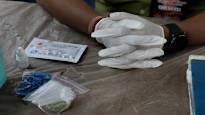Progress has been made in the treatment of HIV, but not everyone can afford the treatment. There were around 40 million HIV-infected people in the world last year.
14:07•Updated 14:10
Of the world’s 39.9 million people infected with HIV, 86 percent know they are infected, says a UN report. The majority of them are receiving treatment or their disease has been suppressed, but nine million of them were not covered by treatment last year.
A lot has been done to reduce infections, but according to the UN, there has also been a slowdown in development.
The virus that causes immunodeficiency is becoming more common in several regions: the Middle East, North Africa, Eastern Europe, Central Asia and Latin America.
Progress has been made, for example, so that there are injections whose effect lasts up to six months. The problem, however, is the price: such injections cost around 36,000 euros per year.
The price of a daily medicinal pill is significantly lower. This kind of treatment costs around 70 euros per year, which has made it possible to increase the number of people covered by the treatment in some countries.
Marginalized groups are at greatest risk
Last year, around 630,000 people died of HIV-related diseases. It is clearly less than the peak year of 2004, but double the goal set by the UN’s UNAIDS organization – the number of infections should be less than 250,000 in 2025.
Infections are especially common among young women in some parts of Africa. The proportion of those living in a marginal position, such as sex workers, has increased.
of the Director of UNAIDS Winnie Byanyiman world leaders promised to end the AIDS pandemic by 2030 so that it would not be a public health risk.
– The promise can only be kept if sufficient funds are put into the fight against HIV, and if everyone’s human rights are respected, Byanyima said.
